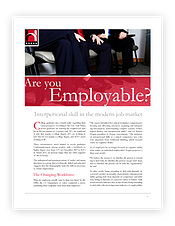 Western societies tend to attribute success to individuals – Hannibal is often seen as the leader who conquered much of the land surrounding the Mediterranean and it was Steve Jobs who transformed Apple into one of the world’s most valued companies. But these individuals would have failed had they worked alone. Hannibal’s success can be rightly attributed to assembling a highly effective army; Steve Jobs’ success depended on highly talented product developers and software engineers. Hannibal and Jobs not only had a knack for gathering the right cast of characters, they were also very adept at putting the right people in the right positions and getting everyone to work together effectively. More often than not, less talented individuals who work well together often accomplish more than talented individuals who play dysfunctional family feud. Despite the fact that all major human accomplishments have been the result of collective rather than individual efforts, systematic research on groups and teams is a relatively recent phenomenon.
Western societies tend to attribute success to individuals – Hannibal is often seen as the leader who conquered much of the land surrounding the Mediterranean and it was Steve Jobs who transformed Apple into one of the world’s most valued companies. But these individuals would have failed had they worked alone. Hannibal’s success can be rightly attributed to assembling a highly effective army; Steve Jobs’ success depended on highly talented product developers and software engineers. Hannibal and Jobs not only had a knack for gathering the right cast of characters, they were also very adept at putting the right people in the right positions and getting everyone to work together effectively. More often than not, less talented individuals who work well together often accomplish more than talented individuals who play dysfunctional family feud. Despite the fact that all major human accomplishments have been the result of collective rather than individual efforts, systematic research on groups and teams is a relatively recent phenomenon.
Most of the research on teams from the late 1940s through the early 1980s was focused on the processes and dynamics associated with leaderless groups. Tuckman’s famous forming, storming, norming, and performing stages of group development was one of the more robust findings from this research and can readily be observed anytime groups of volunteers get together. Yet these four stages rarely occur in the world of work, since competitive threats, authority hierarchies, pre-assigned goals and roles, and time and task pressures profoundly affect group dynamics. Research on work teams over the past 30 years has resulted in these six major findings:
- There are important distinctions between groups and teams. Teams have overarching goals; members do interdependent work and share common fates. Groups are collections of individuals who have individual goals, do independent work, and are rewarded or fail based on their individual efforts.
- Teams are not always more effective than groups. The relative effectiveness of teams versus groups depends on the nature of work to be accomplished; sometimes teams are the best option and other times groups are a better way to go.
- Highly effective groups and teams are relatively rare. People work on many groups and teams over the course of their careers, yet most fail to perform at their potential.
- There is no widely accepted model for building high performing groups and teams. Several models for building teams have been offered but none have been widely adopted.
- Effective leaders are the exception rather than the rule. Somewhere between 65-75 percent of people in positions of authority are unable to build teams or get results.
- Leadership matters. It is true that leaders cannot do it alone and may get a disproportionate amount of credit or blame for team outcomes, but who is in charge does matter. Dysfunctional leaders beget dysfunctional teams.
By Gordon Curphy
Curphy Consulting Corporation
Guest blogger and author of The Rocket Model


 Many organizations encourage their employees to volunteer outside of work or offer employee volunteer programs. For example,
Many organizations encourage their employees to volunteer outside of work or offer employee volunteer programs. For example,  College graduates face a harsh reality regarding their career prospects. According to the New York Times, recent graduates are entering the toughest job market in the last quarter of a century; only 56 percent are employed in jobs that require a college degree, 22 percent are working in jobs that do not require a college degree, and 22.4 percent aren't working at all.
College graduates face a harsh reality regarding their career prospects. According to the New York Times, recent graduates are entering the toughest job market in the last quarter of a century; only 56 percent are employed in jobs that require a college degree, 22 percent are working in jobs that do not require a college degree, and 22.4 percent aren't working at all.  College graduates face a harsh reality regarding their career prospects. According to the New York Times, recent graduates are entering the toughest job market in the last quarter of a century; only 56 percent are employed in jobs that require a college degree, 22 percent are working in jobs that do not require a college degree, and 22.4 percent aren’t working at all.
College graduates face a harsh reality regarding their career prospects. According to the New York Times, recent graduates are entering the toughest job market in the last quarter of a century; only 56 percent are employed in jobs that require a college degree, 22 percent are working in jobs that do not require a college degree, and 22.4 percent aren’t working at all. Bosses from Hell
Bosses from Hell Bosses from Hell
Bosses from Hell

 Earlier this month, I had the pleasure of serving jury duty. I’ve never been summoned to serve on a jury. The holding room for potential jurors is in a hot, windowless basement. The thought of sitting in what Tulsans affectionately call The Cellar Club wasn’t exactly my idea of a good time. I thought I’d pass the time catching up on work or finally finishing The Hunger Games. Instead, I found myself playing my new favorite game – Guess the Hogan Scales. People-watching is the best at the airport and courthouses apparently.
Earlier this month, I had the pleasure of serving jury duty. I’ve never been summoned to serve on a jury. The holding room for potential jurors is in a hot, windowless basement. The thought of sitting in what Tulsans affectionately call The Cellar Club wasn’t exactly my idea of a good time. I thought I’d pass the time catching up on work or finally finishing The Hunger Games. Instead, I found myself playing my new favorite game – Guess the Hogan Scales. People-watching is the best at the airport and courthouses apparently. Ron Ashkenas recently posted an
Ron Ashkenas recently posted an 